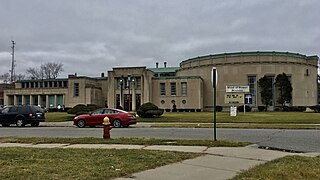
Beth Sholom Congregation is a Conservative Jewish congregation and synagogue located at 8231 Old York Road in Elkins Park, a suburb of Philadelphia, Pennsylvania, in the United States. It is the only synagogue designed by famed architect Frank Lloyd Wright. Completed in 1959, it has been called a "startling, translucent, modernist evocation of an ancient temple, transposed to a Philadelphia suburb by Frank Lloyd Wright". The synagogue building was designated a National Historic Landmark in 2007 for its architecture.

The Eldridge Street Synagogue is an Orthodox Jewish synagogue located at 12 Eldridge Street in Chinatown, in the Lower East Side of Manhattan, in New York City, New York, United States. Built in 1887, the National Historic Landmark is one of the first synagogues erected in the United States by Eastern European Jews.

Congregation Beth Israel is a Reform Jewish congregation and synagogue located at 701 Farmington Avenue, in West Hartford, Connecticut, in the United States.

The First Roumanian-American Congregation, also known as Congregation Shaarey Shomayim, or the Roumanishe Shul, was an Orthodox Jewish congregation at 89–93 Rivington Street on the Lower East Side of Manhattan in New York City. The congregation was organized in 1885 by Romanian-Jewish immigrants, serving the Lower East Side's large Romanian-Jewish community. The Rivington Street building, erected around 1860, switched between being a church and a synagogue and was extensively remodeled in 1889. The First Roumanian-American congregation purchased it in 1902 and again remodeled it.

Congregation Baith Israel Anshei Emes, more commonly known as the Kane Street Synagogue, is an egalitarian Conservative synagogue at 236 Kane Street in the Cobble Hill neighborhood of Brooklyn in New York City, New York, United States. It is the oldest continuously operating synagogue in Brooklyn.

Congregation Beth Elohim, also known as the Garfield Temple and the Eighth Avenue Temple, is a Reform Jewish congregation and historic synagogue located at 274 Garfield Place and Eighth Avenue, in the Park Slope neighborhood of Brooklyn in New York City, New York, United States.

Central Synagogue is a Reform Jewish congregation and synagogue at 652 Lexington Avenue, at the corner of 55th Street in the Midtown Manhattan neighborhood of New York City. The current congregation was formed in 1898 through the merger of two 19th-century synagogues: Shaar Hashomayim and Ahawath Chesed. The synagogue building was constructed from 1870 to 1872 for Ahawath Chesed. As of 2014, Angela Buchdahl is Central's senior rabbi.

The Wilshire Boulevard Temple, known from 1862 to 1933 as Congregation B'nai B'rith, is a Reform Jewish congregation and synagogue, located at 3663 Wilshire Boulevard, in the Wilshire Center district of Los Angeles, California, in the United States. Founded in 1862, it is the oldest Jewish congregation in Los Angeles.

Congregation Beth Israel Ner Tamid is an egalitarian Conservative synagogue located at 6880 North Green Bay Road in Glendale, a suburb north of Milwaukee, Wisconsin, in the United States.

Congregation Beth Israel is a Reform Jewish congregation and synagogue, located at 10460 North 56th Street in Scottsdale, Arizona, in the United States. Incorporated in 1920, the congregation affiliated with the Union for Reform Judaism in 1935.

Adas Israel is a Conservative synagogue in the Cleveland Park neighborhood of Washington, D.C., in the United States. It is the largest Conservative synagogue in the city.

Stephen Wise Free Synagogue is a Reform Jewish synagogue at 30 West 68th Street in the Upper West Side of Manhattan in New York City, New York, U.S. The congregation was the first of multiple "free synagogue" branches in the early 20th century.

Temple Israel is a Reform Jewish synagogue located at 477 Longwood Avenue, in Boston, Massachusetts, in the United States. Founded in 1854 as Adath Israel, the congregation is the largest Reform synagogue in Boston and New England.

Temple Beth-El is a Reform Jewish synagogue located at 2419 Kennedy Boulevard in the Bergen Section of Jersey City, Hudson County, New Jersey, in the United States.

The Temple Society of Concord, commonly referred to as Temple Concord, is a Reform Jewish congregation and synagogue located at 910 Madison Street, in Syracuse, Onondaga County, New York, in the United States.

The Park Avenue Synagogue is a Conservative Jewish congregation at 50 East 87th Street on the Upper East Side of Manhattan in New York City, New York. Founded in 1882, the congregation is one of the largest congregations in the United States.

Temple Israel is a Reform Jewish synagogue located at 5725 Walnut Lake Road, in West Bloomfield Township, Oakland County, Michigan, in the United States.

Anshei Minsk is a synagogue in the Kensington Market neighbourhood of Toronto, Ontario, Canada. It was founded in 1912 by poor Jewish immigrants from what is now Belarus, which at the time was part of the Russian Empire. The current Byzantine Revival building was completed in 1930.

Congregation Etz Hayim at Hollis Hills Bayside is an egalitarian Conservative synagogue located in the neighborhood of Hollis Hills in Queens, New York City, New York, United States. The congregation was formed through a May 2021 consolidation of the Hollis Hills Bayside Jewish Center and the Marathon Jewish Community Center.

Temple Adath Israel of the Main Line is a Conservative synagogue located in Merion, Pennsylvania, in the United States. The synagogue offers religious services, pre-school, Hebrew Sunday school, adult education, and community programming. It was founded in 1946 and moved to its current location in 1953. The congregation serves approximately 800 families. Rabbi Eric Yanoff has served as senior rabbi since 2010.


























